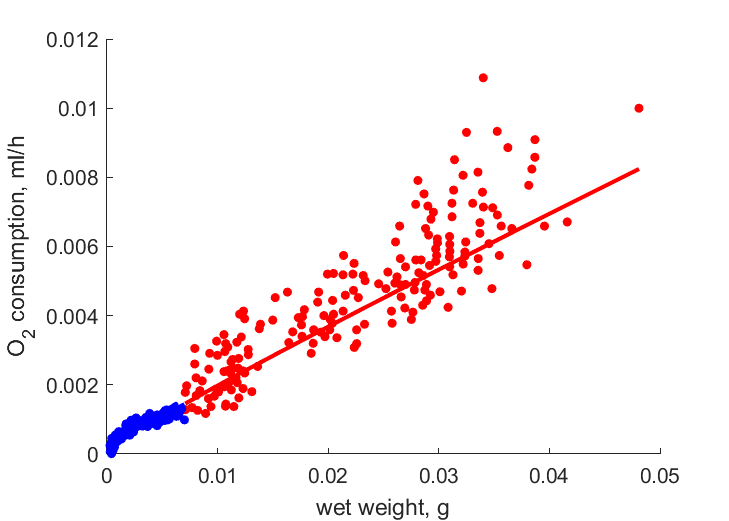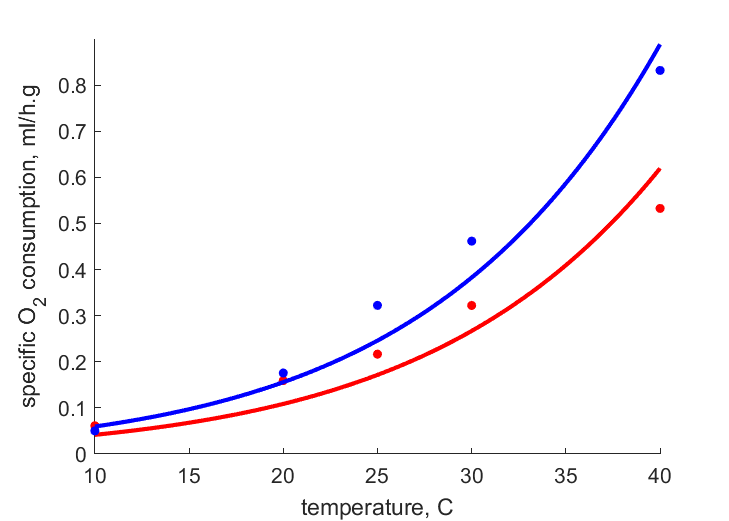Predictions & Data for this entry
| Model: abj | climate: A, B, C, D | migrate: | phylum: |
| COMPLETE = 2.5 | ecozone: TH, TN, TA, TP | food: biD | class: |
| MRE = 0.129 | habitat: 0iTf | gender: D | order: |
| SMSE = 0.029 | embryo: Ts | reprod: O | family: |
Zero-variate data
| Data | Observed | Predicted | (RE) | Unit | Description | Reference |
|---|---|---|---|---|---|---|
| ab | 43 | 40.5 | (0.05821) | d | age at birth | urban |
| tp | 91.5 | 126.9 | (0.3874) | d | time since birth at puberty | Wiki |
| am | 912.5 | 909.7 | (0.003077) | d | life span | Wiki |
| Lb | 0.2 | 0.2166 | (0.08291) | cm | total length at birth | guess |
| Lp | 0.6 | 0.5663 | (0.05621) | cm | total length at puberty | Wiki |
| Li | 1.2 | 1.18 | (0.01642) | cm | ultimate total length | Wiki |
| Wwb | 0.28 | 0.3141 | (0.1217) | mg | wet weight at birth | DeVrAppe2013 |
| Wwp | 7 | 5.614 | (0.1981) | mg | wet weight at puberty | DeVrAppe2013 |
| Wwi | 48.09 | 50.83 | (0.05701) | mg | ultimate wet weight | DeVrAppe2013 |
| Ni | 100 | 109.7 | (0.09658) | #/d | total # of eggs | Wiki |
Uni- and bivariate data
| Data | Figure | Independent variable | Dependent variable | (RE) | Reference |
|---|---|---|---|---|---|
| WJO_ad |   | wet weight | O_2 consumption | (0.1782) | DeVrAppe2013 |
| WJO_juv |   | wet weight | O_2 consumption | (0.2211) | DeVrAppe2013 |
| TjO_ad |   | temperature | specific O_2 consumption | (0.1995) | DeVrAppe2013 |
| TjO_juv |   | temperature | specific O_2 consumption | (0.1312) | DeVrAppe2013 |
Pseudo-data at Tref = 20°C
| Data | Generalised animal | Lepisma saccharina | Unit | Description |
|---|---|---|---|---|
| v | 0.02 | 0.003825 | cm/d | energy conductance |
| p_M | 18 | 113.8 | J/d.cm^3 | vol-spec som maint |
| k_J | 0.002 | 0.002 | 1/d | maturity maint rate coefficient |
| k | 0.3 | 0.07772 | - | maintenance ratio |
| kap | 0.8 | 0.8854 | - | allocation fraction to soma |
| kap_G | 0.8 | 0.8043 | - | growth efficiency |
| kap_R | 0.95 | 0.95 | - | reproduction efficiency |
Facts
- continue to moult during their whole life, more than 50 times (Ref: Wiki)
- Nymphs undergo six to seven molts (Ref: urban)
- Thysanurans can survive prolonged periods of starvation (Ref: DeVrAppe2013)
Bibliography